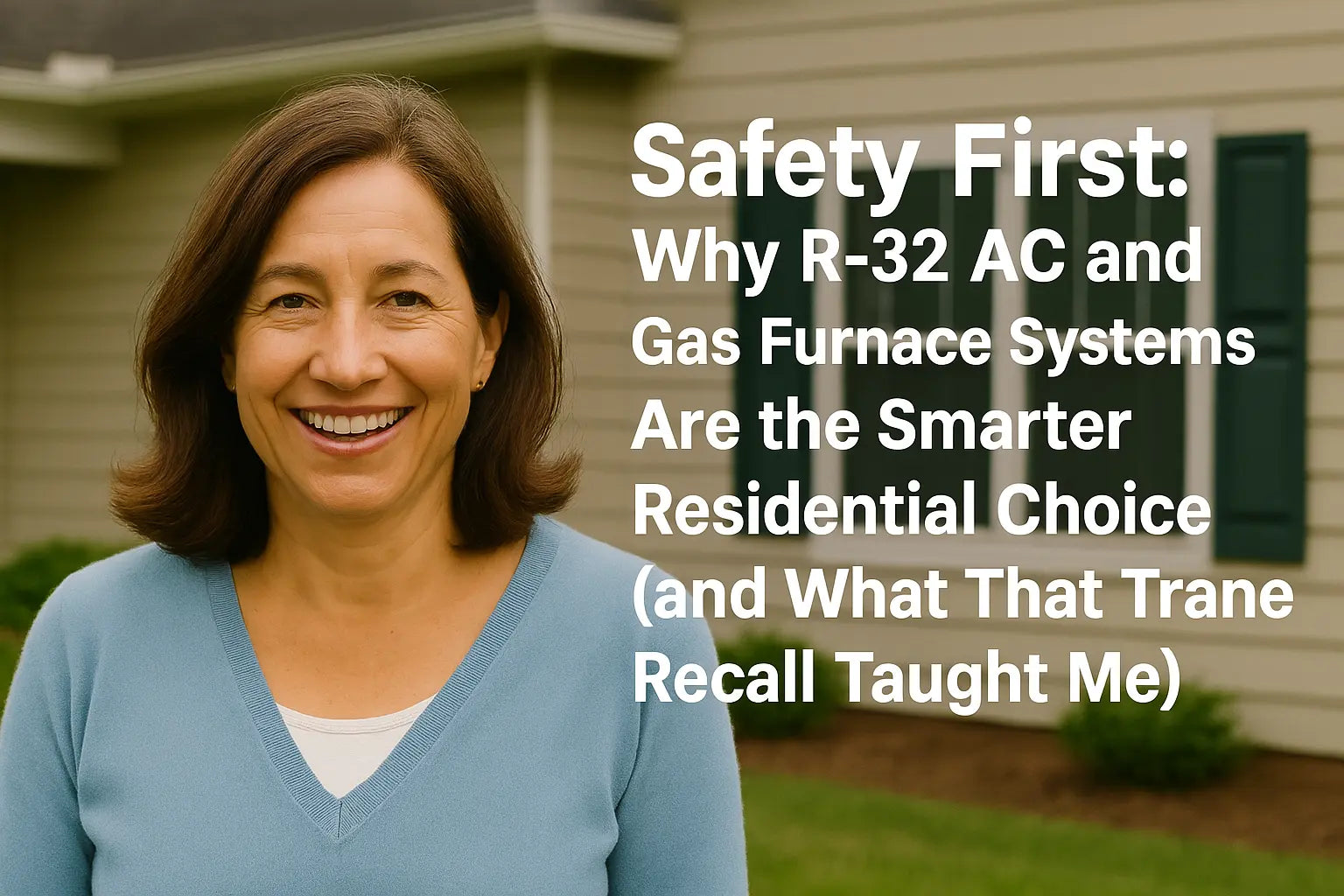From One Smart Shopper to Another 💁
Hey there, it’s Samantha—your favorite slightly obsessive, comfort-seeking, utility-bill-watching home manager. And today, I want to talk about something a bit heavier than the usual BTU chatter: safety.
When Trane issued a voluntary recall of 42,000+ gas/electric packaged units, I had a bit of a flashback. A few years ago, my HVAC unit shorted out on the coldest night of the year—and let me tell you, a chilly toddler at 3 a.m. is not the vibe.
This recall hit home. Not because I own a Trane (I don’t), but because it reminded me just how high the stakes are with home heating and cooling. So let’s unpack why I chose an R-32 AC and gas furnace system, how it stacks up against the old-school models, and what every homeowner needs to know post-recall.
What Was the Trane Recall All About?
In April 2024, Trane Technologies and American Standard issued a voluntary recall of certain gas/electric packaged units due to a potential fire hazard. According to the U.S. Consumer Product Safety Commission (CPSC), wiring within the heat exchanger compartment could overheat, creating a risk of fire.
Here’s the official recall notice from CPSC.gov.
These were not some ancient relics, either. Many were manufactured between 2019 and 2023. That means thousands of homeowners are potentially running recalled units right now and don’t even know it.
Why This Got Me Rethinking My HVAC Strategy 🔍
I’ll be honest—I’ve always leaned on name brands. But as I dug into the recall, I started to realize something else:
Even premium units can have flaws.
It’s not just about the brand anymore. It’s about materials, refrigerant choice, and system design.
Why I Chose R-32 Over R-410A (And You Should Too)
If you're still using a system with R-410A, it's time to catch up. The industry is phasing it out due to its global warming potential (GWP). While R-410A has a GWP of 2,088, R-32 clocks in at just 675. That’s a huge win for the planet and your long-term costs.
In fact, the EPA’s Significant New Alternatives Policy (SNAP) program has flagged R-32 as a more environmentally responsible option, and ASHRAE lists it as A2L—meaning it’s low-toxicity and only mildly flammable, with higher efficiency. (Source)
Also worth noting: R-32 systems typically have simpler designs, lower charge volumes, and better thermal conductivity, which means your system works smarter, not harder. I love that.
Gas Furnace Safety: Why I Stick with High-Efficiency Systems
Back to the Trane situation: the fire hazard came from wiring inside the heat exchanger compartment, an area critical to any gas furnace. That’s why I only go with systems that meet or exceed 96% AFUE (Annual Fuel Utilization Efficiency).
The Goodman system I chose has:
-
Sealed combustion chambers
-
High-efficiency variable-speed blowers
-
Smart diagnostics with integrated controls
It meets the DOE’s 2023 federal minimum energy conservation standards, which you can verify at Energy.gov.
Combos Just Make Sense: AC + Gas Furnace in One Smart Setup
Here’s what really sealed the deal: the Goodman R-32 AC and natural gas furnace combo is designed as a matched system. That means:
-
No mix-and-match compatibility drama
-
Streamlined install (my tech was in and out in 1 day!)
-
Optimized performance and airflow
You wouldn’t mix champagne with boxed wine—so why mismatch your indoor coil and condenser?
What Should You Ask Your Installer Post-Recall? 🛠️
If this Trane recall has you wondering what’s humming (or sparking) inside your HVAC closet, I’ve got your back.
Here’s a short checklist to ask your technician:
-
Has my current unit ever been recalled?
-
Is it running on R-410A or R-32?
-
Is my furnace a sealed combustion unit?
-
Does my unit have integrated overheat protection?
-
What are my options for upgrading to an R-32/gas combo?
Oh—and don’t forget to verify your installer's credentials. You can double-check licenses at sites like NATE or HVAC Excellence.
Want Lower Energy Bills? Go Hybrid (Like I Did) 💸
One thing I didn’t expect with the Goodman R-32 system? My utility bill dropped by 22% in the first winter alone.
I layered my system with a smart thermostat and got guidance through Energy Star’s home upgrade pathway (Energy Star recommendations here).
Bonus: R-32’s efficiency helps shorten run cycles, and paired with a high-efficiency gas furnace, it keeps your indoor temps super steady—no wild swings or freezing mornings anymore.
When Should You Replace Your System? ⏳
Let me be real for a second: if your system is older than 10–12 years and runs on R-22 or R-410A, it’s time to think about a replacement—especially if it’s out of warranty or hasn’t been serviced in over a year.
I snagged rebates and tax credits through DSIRE, which made the transition more affordable than I thought.
What I’d Tell My Best Friend (And Now You) ❤️
Listen, we all want comfort, value, and safety in our homes. But when something like the Trane recall happens, it’s a reminder: this stuff matters.
The Goodman R-32 system isn’t just a greener option—it’s a safer, smarter, future-ready solution for your home. I sleep better knowing that what’s keeping my family warm (or cool) is built with both performance and protection in mind.
If you're on the fence, do yourself a favor and browse the full lineup at The Furnace Outlet. They’ve got the real-deal specs, not just the marketing fluff.
Curious about R-32 refrigerant when it comes to these systems? Visit my guide: What Is R-32 and Why Are HVAC Pros Swapping Out R-410A? (Spoiler: That Trane Recall Was My Wake-Up Call).
Love, Peace, and Lower Energy Bills ✌️
Catch you next time,
– Samantha, Your Home Comfort Advisor 🏡







